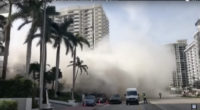After Maiming, Rethinking Explosions as Entertainment

I n 1997, a 13-year-old girl and her family stopped to watch an explosive demolition of an abandoned hospital in Australia. She was killed by flying debris. "Almost overnight, implosions worldwide ceased being actively promoted as spectator events," wrote Brent L. Blanchard, operations manager for consultant Protec Documentation Services, Rancocas Woods, N.J., in his history of the demolition technique.
Now there is a sad new chapter. California officials are investigating what went wrong during the Aug. 3 implosion of a Pacific Gas & Electric Co.-owned power- plant in Bakersfield that propelled shrapnel more than 1,000 ft toward a large crowd of spectators, injuring several and partially severing one man's leg.
A safety zone had been established for spectators at the powerplant site, according to local media.
In a statement, lead demolition contractor Cleveland Wrecking Co. called it "a terrible accident" and pledged to cooperate with authorities conducting a full investigation. Last year, Cleveland Wrecking was cited by Cal-OSHA after a worker on the same project was killed when the aerial lift he was working on was struck by a collapsing beam.
Officials of one subcontractor, Alpha Explosives, Lincoln, Calif., could not be reached for comment. Another subcontractor, DemTech LLC, declined to comment as an investigation is under way.
In a statement, PG&E said it "will work closely with all investigating agencies and the third-party contractors who managed and carried out the demolition" to identify the cause.
Explosive demolition has been thought of as a way to limit hazards to demolition workers, and, over the decades, the blasts have been embraced by audiences. As the media continued to publicize these projects, wrote Blanchard, blasters have continued to struggle with crowd control and related issues, including, in the 1990s, a turn that brought a noticeable shift toward "promotional responsibility," resulting in the safe completion of thousands of recent projects.
Brenton Malin, a professor of communications at the University of Pittsburgh, said news about buildings falling down is low-hanging fruit for the media.
"Spectators like buildings exploding, and it's good news for the media because it's safe news. You can cover it without it being controversial," Malin says.
Blasters don't crave live audiences, say contractors and consultants. Mark Loizeaux, president of Controlled Demolition Inc., said his firm has never invited the public to view an implosion. "We feel it's not a spectator sport. Regulatory codes prohibit employees or other persons in areas where there could be flying debris."
Only a handful of companies perform the work, and, although employees have been hurt, the accidents have been few. Keeping spectators away may become a new priority again. Blanchard says he has never seen a blast team actively promote people coming any closer to the blast than watching it on the television news. n






